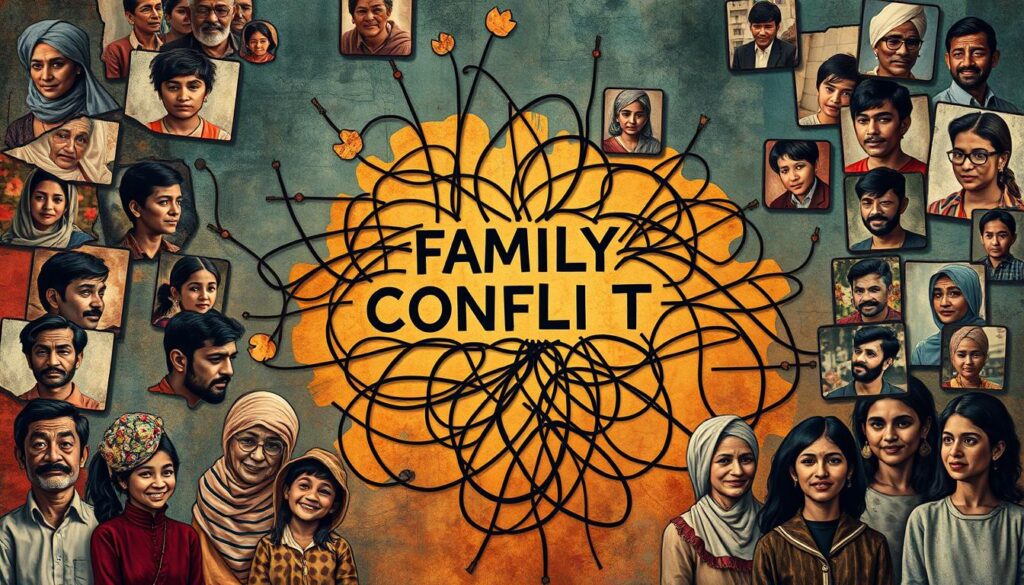
Family conflicts are a common challenge many of us face. Whether it’s adult children moving back in with parents or couples navigating relationship challenges, it’s a universal issue. Stanford research shows nearly 70% of heterosexual unmarried couples break up within the first year1. First marriages have a 40% chance of divorce, with subsequent marriages even higher1. However, with the right strategies and a commitment to effective conflict resolution, we can maintain healthy relationships and avoid becoming part of these statistics.
Key Takeaways
- Family conflicts are common but can be effectively resolved with the right approach
- Healthy communication and open-mindedness are key to finding peaceful resolutions
- Taking a timeout during heated arguments can prevent escalation
- Seeking external support from a mediator or therapist can help navigate complex issues
- Recognizing our own role in conflicts and adjusting our responses can make a significant difference
Understanding the Root Causes of Family Conflict
Navigating family dynamics is complex and challenging. To effectively address and resolve family conflicts, understanding the underlying factors is crucial. From common triggers in modern family life to generational differences and past experiences, exploring these root causes is key to finding lasting solutions.
Common Triggers in Modern Family Dynamics
Family conflicts often arise during periods of transition or change. This includes moving in or out of a home, marriage, divorce, relocation, job changes, the birth of a baby, going to college, serious illness, or children starting extracurricular activities2. Financial disagreements, care responsibilities for aging parents, and differences in religious or political views also serve as catalysts for family disputes3. These triggers can significantly impact family members’ mood and performance at work, school, and other activities2.
The Impact of Generational Differences
Generational differences within families can lead to misunderstandings and conflicts. Varying perspectives, values, and communication styles create barriers to effective conflict resolution. For instance, studies show that over 70% of mothers in a study examining estrangement between mothers and adult children attribute the rift to other family members, often the child’s partner or spouse3. Additionally, relationships with in-laws are particularly challenging, with studies indicating that issues with in-laws account for a significant portion of family conflicts3.
How Past Experiences Shape Current Conflicts
The past often casts a long shadow over present-day family dynamics. Childhood experiences, parenting styles, and deeply ingrained patterns of behavior shape how individuals approach and navigate family conflicts4. Poor relationships with parents, siblings, or spouses have been linked to midlife depression symptoms3. Understanding how these past experiences influence current conflicts is crucial for breaking negative cycles and fostering healthier communication and conflict resolution strategies.
By delving into common triggers, generational differences, and the impact of past experiences, families can gain valuable insights into the root causes of their conflicts. This understanding serves as a foundation for developing more effective family counseling techniques and fostering greater emotional intelligence within the family unit.

“Resolving conflicts successfully involves ensuring that all involved feel heard, understood, and respected, even if opinions are not heeded.”2
Relationship Advice for Handling Family Conflicts
Dealing with family conflicts can be tough, but the right approach can help us overcome them5. It’s vital to use empathy, stay open-minded, and seek common ground. This mindset is crucial for resolving disputes effectively.
Starting with honest talks about expectations and concerns is key5. Keeping the conversation respectful, even when emotions run high, is essential5. It’s also important to tackle the root causes of conflicts, not just the symptoms.
Compromise is vital in family ties5. Learning to choose your battles wisely can prevent conflicts from getting worse5. Sharing common goals and values strengthens family bonds5.
In some cases, cutting ties with a family member might be necessary for your mental health6. This decision, though hard, can positively impact your life6. Forgiveness is also crucial for healing and reducing conflict’s negative effects6.
Resolving family conflicts requires patience, empathy, and a commitment to work through issues together7. By promoting open dialogue, compromise, and understanding, we can build stronger family ties and solve complex problems567.
| Communication Skills | Mediation Strategies | Conflict Resolution Techniques |
|---|---|---|
| Active listening | Identifying underlying needs | Compromise and negotiation |
| Using “I” statements | Avoiding blame and criticism | Setting healthy boundaries |
| Emotional regulation | Focusing on common ground | Forgiveness and healing |
By using these communication, mediation, and conflict resolution strategies, families can overcome even the toughest conflicts567.
Essential Communication Skills for Resolving Family Disputes
Effective communication is the cornerstone of resolving family conflicts. By mastering active listening, using “I” statements, and managing emotional responses, families can navigate challenging situations with greater understanding and empathy8.
Active Listening Techniques
Active listening involves giving your undivided attention, making eye contact, and responding thoughtfully to what is being said. This not only helps you better understand the other person’s perspective but also conveys that you genuinely care about their feelings and experiences8.
Using “I” Statements Effectively
Framing your thoughts and feelings using “I” statements, rather than blaming or accusing language, can diffuse tension and promote open dialogue. Expressing how you feel, rather than what the other person has done wrong, encourages mutual understanding and problem-solving8.
Managing Emotional Responses
Family conflicts can quickly escalate when emotions run high. By recognizing and regulating your own emotional reactions, you can maintain a respectful and constructive tone, even in the midst of a heated discussion. Taking breaks or practicing mindfulness can help you stay calm and focused8.
Ultimately, mastering these essential communication skills can transform family disputes into opportunities for growth and deeper connection8. By approaching conflicts with patience, empathy, and a willingness to listen, families can navigate even the most challenging situations and emerge stronger than before9.

“Effective communication is not about being right, it’s about understanding each other and finding a solution that works for everyone.” – John Gottman, renowned relationship expert
Setting Healthy Boundaries in Family Relationships
As a family member, I’ve learned the value of setting healthy boundaries. They’re key to keeping relationships positive. Clear boundaries prevent conflicts and promote mutual respect10. A study showed that mixing personal and work life increases emotional exhaustion and lowers happiness11. Setting boundaries can also reduce anxiety, stress, and resentment in family ties.
Healthy boundaries cover physical, sexual, emotional, material/financial, and time aspects10. Various types of boundaries were discussed, along with examples of how they evolve. Unhealthy boundaries, on the other hand, can be too strict or too loose10. Struggles with unhealthy boundaries stem from a need for control, fear of rejection, or low self-esteem.
12 Families with unhealthy boundaries often face conflict, drama, and distrust12. This shows boundary issues are common in families. Good communication and boundary setting are vital for healthy family dynamics11. Clearly stating consequences for boundary violations is crucial. Choosing appropriate consequences helps set clear expectations.
